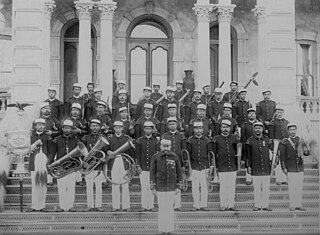 W
WThe Hawaiian rebellions and revolutions took place in Hawaii between 1887 and 1895. Until annexation in 1898, Hawaii was an independent sovereign state, recognized by the United States, United Kingdom, France and Germany with exchange of ambassadors. However, there were several challenges to the reigning governments of the Kingdom and Republic of Hawaii during the 8 1⁄2-year (1887–1895) period.
 W
WThe Honolulu Courthouse riot, or the Election riot, occurred in February 1874 when Hawaiian followers of Queen Emma, known as Emmaites, attacked supporters of King Kalakaua on the latter's election day and started a riot. Marines and sailors from three American and British warships were landed and they successfully quelled the rioters and Kalakaua took the oath of office the following day without further opposition.
 W
WThe Honolulu Rifles were the name of two volunteer military companies of the Hawaiian Kingdom. The second company was composed solely of white citizens.
 W
WHHMS Kaimiloa was the first and only ship of the Hawaiian Royal Navy. The ship was formerly the Explorer, a 170-ton schooner, built in England in 1871. Kaimiloa sailed from Hawaii to Samoa and other Pacific islands in 1887 in an effort by King Kalākaua to form a confederation of Polynesian states to counteract European imperialism. The instance nearly resulted in military conflict between the Kingdom of Hawaii and the German Empire, who viewed Samoa as their possession in the Pacific. It was also used as a training ship.
 W
WThe Royal Guard of the Hawaii National Guard is an Air National Guard ceremonial unit which is uniformed in a manner similar to the royal bodyguard of the Kingdom of Hawaii of the late 19th century. The original 50-man unit had been disbanded by King Lunalilo after the barrack mutiny of 1873, reestablished by King Kalakaua, and finally abolished when the monarchy fell in revolution at the end of the 19th century.
 W
WThe Royal Hawaiian Band is the oldest and only full-time municipal band in the United States. At present a body of the City & County of Honolulu, the Royal Hawaiian Band has been entertaining Honolulu residents and visitors since its inception in 1836 by Kamehameha III. During the monarchy it was nominally a military band. It reached global prominence under the leadership of Prussian Heinrich "Henri" Berger, an officer of the imperial German army loaned to the Kingdom of Hawaiʻi in 1872. Berger composed many beloved marching tunes and other melodies, and would later be honored with the title of "Father of Hawaiian Music." He collaborated with King Kalākaua in creating Hawaiʻi Ponoʻi, the national anthem of Hawaiʻi; it is still used today as the official state song.
 W
WThe Wilcox rebellion of 1889 was a revolt led by Robert Wilcox to force King Kalākaua of Hawaii to reenact the Hawaiian Constitution of 1864 from the Constitution of 1887.